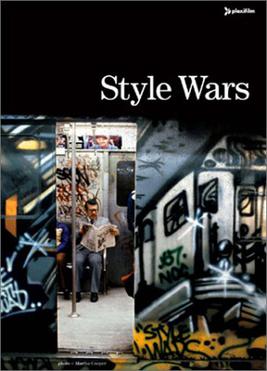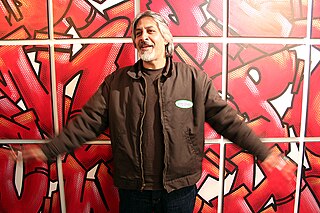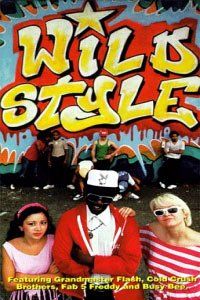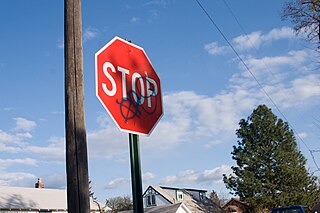
Graffiti is writing or drawings made on a wall or other surface, usually without permission and within public view. Graffiti ranges from simple written "monikers" to elaborate wall paintings, and has existed since ancient times, with examples dating back to ancient Egypt, ancient Greece, and the Roman Empire.

Fred Brathwaite, more popularly known as Fab 5 Freddy, is an American visual artist, filmmaker, and hip hop pioneer. He is considered one of the architects of the street art movement. Freddy emerged in New York's downtown underground creative scene in the late 1970s as a graffiti artist. He was the bridge between the burgeoning uptown rap scene and the downtown No Wave art scene. He gained wider recognition in 1981 when Debbie Harry rapped on the Blondie song "Rapture" that "Fab 5 Freddy told me everybody's fly." In the late 1980s, Freddy became the first host of the groundbreaking hip-hop music video show Yo! MTV Raps.

Style Wars is an American 1983 documentary film on hip hop culture, directed by Tony Silver and produced in collaboration with Henry Chalfant. The film has an emphasis on graffiti, although bboying and rapping are covered to a lesser extent. The film was originally aired on the television network PBS and was subsequently shown in several film festivals to much acclaim, including the Vancouver Film Festival. It also won the Grand Jury Prize: Documentary at the Sundance Film Festival.

Leonard Hilton McGurr, known as Futura, and formerly known as Futura 2000, is an American contemporary artist and former graffiti artist.

Richard Mirando, known as Seen, is an American graffiti artist. He is one of the best known graffiti artists in the world and has been referred to as the Godfather of Graffiti.

Wild Style is a 1983 American hip hop film directed and produced by Charlie Ahearn. Regarded as the first hip hop motion picture, it includes appearances by seminal figures such as Fab Five Freddy, Lee Quiñones, Lady Pink, The Rock Steady Crew, The Cold Crush Brothers, Rammellzee with Shockdell, Queen Lisa Lee of Zulu Nation, Grandmaster Flash, and ZEPHYR.

ZEPHYR, born Andrew Witten, is a graffiti artist, lecturer and author from New York City. He began writing graffiti in 1975 using the name "Zephyr" in 1977. He is considered a graffiti "elder", who along with Futura 2000, Blade, PHASE 2, CASH, Lady Pink and TAKI 183 invented styles and standards which are still in use.

Steffan "Mr. Wiggles" Clemente is a street dancer, noted for his popping skills. He is a member of the Rock Steady Crew, The Electric Boogaloos, Tribal Click, Zulu Nation, and TC5, also known as The Cool Five or The Crazy Five. Wiggles has been active as a dancer, actor, choreographer, dance instructor, music producer and graffiti artist.
George Lee Quiñones is a Puerto Rican artist and actor. Quiñones rose to prominence by creating massive New York City subway car graffiti that carried his moniker "LEE". His style is rooted in popular culture and often with political messages.
Lady Pink, born Sandra Fabara, is an Ecuadorian-born American graffiti and mural artist, active in New York City.

Martha Cooper is an American photojournalist. She worked as a staff photographer for the New York Post during the 1970s. She is best known for documenting the New York City graffiti scene of the 1970s and 1980s.

Michael Christopher Tracy, known as Tracy 168, was an American graffiti artist. He pioneered the art form known as wildstyle. Tracy 168 came to be known as one of the most influential graffiti and street artists of all time, as variations of wildstyle writing spread around the world. He is acknowledged to have been a seminal figure in the development of street art. Books about 1970s graffiti feature his car-long paintings with their characteristic kinetic script embellished with flames, arrows as well as cartoon characters and the "Tracy face," a grinning shaggy-haired visage in wrap-around shades.
Charlie Ahearn is an American film maker living in New York City. Although predominantly involved in film and video art production, he is also known for his work as an author, freelance writer, member of Colab, and radio host. He is married to the painter Jane Dickson and is the twin brother to the sculptor John Ahearn.
Carlos Rodriguez, better known as Mare139, is a New York-based artist born in 1965 in Spanish Harlem, New York City. He was best known as the subway graffiti writer Mare 139, and has since adapted the graffiti lettering styles to metal sculpture in the fine art context, and is recognized as a media artist for his creation of graffiti-art-related websites.
George Ibañez, also known as “Crime79”, is a New York City-based graffiti artist. His style is rooted in popular culture and often with political messages.

Graffiti are writing or drawings scribbled, scratched, or sprayed illicitly on a wall or other surface in a public place. Graffiti ranges from simple written words to elaborate wall paintings. Graffiti, consisting of the defacement of public spaces and buildings, remains a nuisance issue for cities.

Graffiti in New York City has had a substantial local, national, and international influence.

Brim Fuentes, is the founding member of graffiti crew TATS CRU, and was born in the South Bronx, New York City. Brim was fortunate enough to start writing graffiti in one of the most important periods of graffiti history. He began bombing and hitting New York City Subway trains, in the late 1970s, all the way through to the mid-1980s. After the trains were cleaned in 1989 he and the rest of TATS CRU took to the streets and began bombing and creating street art all over the city.
Sacha Jenkins is an American television producer, filmmaker, writer, musician, artist, curator, and chronicler of hip-hop, graffiti, punk, and metal cultures. While still in his teens, Jenkins published Graphic Scenes & X-Plicit Language, one of the earliest 'zines solely dedicated to "graffiti" art. In 1994, Jenkins co-founded Ego Trip magazine. In 2007, he created the competition reality program ego trip's The (White) Rapper Show, which was carried by VH1. Currently, Jenkins is the creative director of Mass Appeal magazine.
United Graffiti Artists was an early American graffiti artists collective, founded in 1972 by Hugo Martinez in New York City. UGA was the first organized group of writers, and the first to promote graffiti as a high art. Martinez, then a student activist at City College of New York, organized a group of teenagers who had been tagging the subways into a loose collective, formalizing their work and paving the way for commercialization. In September 1973, UGA organized the first ever gallery show of graffiti at the Razor Gallery in SoHo.













